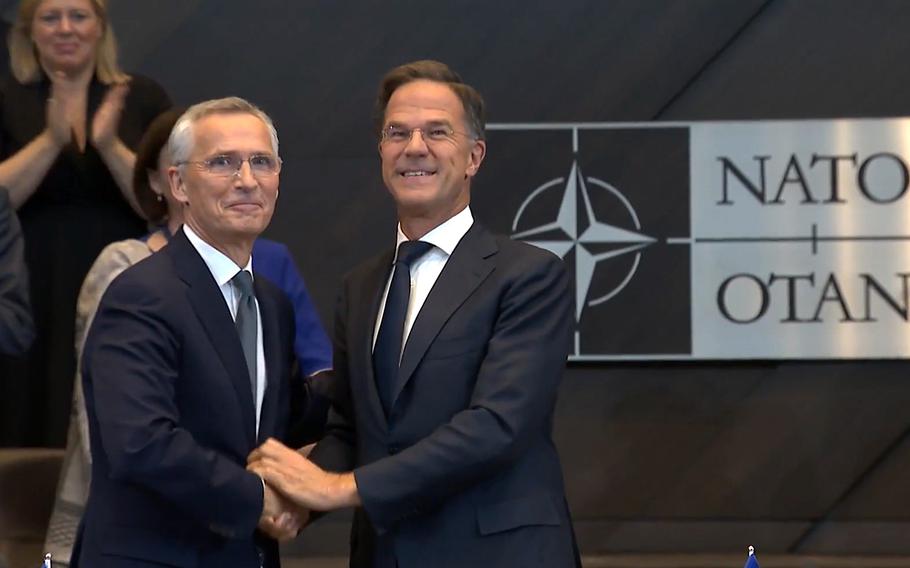
New NATO Secretary-General Mark Rutte, right, shakes hands with his predecessor Jens Stoltenberg after taking the helm of the alliance at a ceremony at its headquarters in Brussels, Oct. 1, 2024. (NATO)
Leadership of the 32-nation NATO alliance changed hands Tuesday for the first time in a decade as former Dutch Prime Minister Mark Rutte took the helm of a military bloc facing security challenges unrivaled since the Cold War era.
Rutte replaced Jens Stoltenberg, who for 10 years led NATO’s efforts to rebuild itself to counter a renewed threat from Russia.
Stoltenberg also guided the U.S.-led alliance during the White House tenure of Donald Trump, whose frequent criticism of the alliance created uncertainty about the future of American commitment to NATO, which the country started in the aftermath of World War II.
Moments after taking on the title of NATO secretary-general, Rutte faced questions about how he would deal with Trump should the Republican nominee return to the White House next year.
“I’m not worried,” Rutte said. “I will be able to work with both (candidates) whatever the outcome of the election.”
For any NATO chief, the most critical part of the job is managing the alliance’s relationship with the United States.
Rutte’s reputation for having a deft diplomatic touch was likely a factor in his selection by members to replace Stoltenberg, who himself was referred to at times by NATO insiders as the “Trump whisperer.”
Rutte showcased some of those diplomatic skills during the 2018 NATO summit, in which there were concerns that Trump was poised to withdraw the U.S. from the security bloc.
During a crisis meeting of heads of state, Rutte was said to have realized that the key was to give Trump credit for calling out allies for their lack of defense spending and demanding more spending in the future. Past U.S. presidents had done the same for decades, though in more diplomatic terms.
On Tuesday, Rutte restated that Trump deserved credit.
“He was the one pushing us to spend more,” Rutte said.
For NATO members, defense spending started inching up after Russia’s 2014 armed takeover of Ukraine’s Crimean Peninsula and picked up momentum during Trump’s time in office.
Those expenditures have only accelerated since then, with Russia’s 2022 full-scale invasion of Ukraine pushing allies to spend even more.
Meanwhile, 23 of NATO’s 32 countries hit the benchmark that called for members to spend at least 2% of their gross domestic product on military matters by 2024. A decade ago, only three hit the mark.
Besides questions about defense spending and the outcome of the upcoming U.S. election and what effect that could have on NATO operations, the alliance is grappling with immediate threats on its periphery.
With no end in sight to Russia’s war in Ukraine, the NATO chief will need to carry on efforts to fine-tune defense plans for higher numbers of alliance troops to be able to defend territory on short notice.
“Over this decade, we have implemented the biggest reinforcement of NATO, our collective defense, in a generation, with a higher readiness, more troops in the eastern part of the alliance,” Stoltenberg said Tuesday.
During his tenure, the alliance saw the addition of four new member countries: North Macedonia, Montenegro, Finland and Sweden.
The longtime neutrality of the two Nordic states quickly ended in response to the 2022 invasion as both chose to seek NATO membership, a change that was almost unthinkable just a few years before.
NATO also is playing a larger role in coordinating military assistance for Ukraine, which until recently was spearheaded by the United States.
“We have gone from only providing marginal support to Ukraine back in 2014 to now providing massive support ... and NATO coordinating the support to Ukraine with a new command in Germany,” Stoltenberg said.
Rutte said maintaining allied support for Ukraine will be one of his main efforts.
“We have to make sure that Ukraine prevails as a sovereign, independent, democratic nation,” Rutte said.
Rutte also addressed the consequences of not supporting Ukraine in referring to the 2014 downing of Malaysia Airlines Flight 17, which took off from Amsterdam and was shot down over eastern Ukraine.
Nearly 300 people, including 196 Dutch nationals, were killed when a Russian-made anti-aircraft missile downed the aircraft.
“I know from personal experience … how the conflict in Ukraine is not contained to the front lines,” Rutte said.
As Ukraine struggles to blunt Russian advances, Kyiv is pushing allies for permission to use Western-supplied weapons to hit targets against military sites deeper in Russia.
Rutte said such strikes are legitimate.
“Ukraine is fighting a war of self-defense … and as we know, according to international law, this right does not end at the border,” he said.
Still, mindful of his role as NATO’s chief dealmaker, he said he was in no position to demand allies permit such strikes. So far, the Biden administration has been reluctant to greenlight Kyiv’s request.
“This is for the individual allies in their relationship with Ukraine (to decide),” Rutte said. “But obviously this is an important debate.”